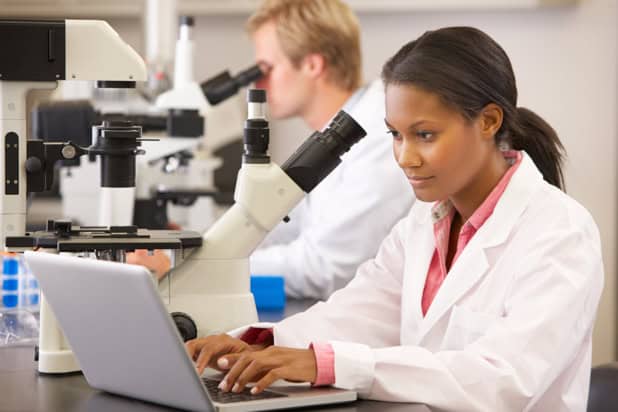


A conversation about theoretical ecology with physicists Ada Altieri and Silvia De Monte
AI4S will meet the need for high-quality journals dedicated to artificial intelligence
The first generative AI tool to be integrated into a clinical workflow eases the creation of radiography reports
Odds of a collision in the next 10 billion years may be only 50/50, according to new simulations
First high-resolution images of Bolivia's Uturuncu volcano show it is likely to remain active without actually erupting
Efimov states could be used to build molecules and achieve nuclear fusion
“Toy model” could be tested using photons
The presence of disorder causes worms to speed up, not slow down – a surprising result with applications in robotics

Can you make an impact through peer review?
Join more than 15,000 researchers who have achieved IOP Trusted Reviewer status – Tell me more
 Read article: Reversible computing could help solve AI’s looming energy crisis
Read article: Reversible computing could help solve AI’s looming energy crisis
Hannah Earley of Vaire Computing is our podcast guest
 Read article: Abnormal ‘Arnold’s tongue’ patterns appear in a real oscillating system
Read article: Abnormal ‘Arnold’s tongue’ patterns appear in a real oscillating system
Ultrafast laser sheds new light on complex synchronization phenomena
 Read article: Quantum computer generates strings of certifiably random numbers
Read article: Quantum computer generates strings of certifiably random numbers
Quantinuum’s trapped-ion computer has also been used to study problems in quantum magnetism and knot theory
 Read article: AI speeds up detection of neutron star mergers
Read article: AI speeds up detection of neutron star mergers
New approach could aid “multimessenger” astronomy by quickly locating sources of gravitational waves emitted during these cosmic events
 Read article: AI and the future of physics
Read article: AI and the future of physics
How artificial intelligence is accelerating discoveries – and raising profound questions – about the future of physics
 Read article: Are you better than AI? Try our quiz to find out
Read article: Are you better than AI? Try our quiz to find out
Iulia Georgescu and Matin Durrani invite you to test your knowledge of the deep connections between physics, big data and AI
 Read article: Curious consequence of special relativity observed for the first time in the lab
Read article: Curious consequence of special relativity observed for the first time in the lab
Real 3D objects appear rotated rather than contracted when moving at relativistic speeds
 Read article: Quantum-inspired technique simulates turbulence with high speed
Read article: Quantum-inspired technique simulates turbulence with high speed
Simulations could take just a few hours rather than several days
 Read article: ‘Sneeze simulator’ could improve predictions of pathogen spread
Read article: ‘Sneeze simulator’ could improve predictions of pathogen spread
3D nasal cavity model could also inform the design of masks and ventilation systems
 Read article: Modelling the motion of confined crowds could help prevent crushing incidents
Read article: Modelling the motion of confined crowds could help prevent crushing incidents
A new study of how dense human crowds move in confined spaces could help predict potentially life-threatening collective motions
 Read article: Elastic response explains why cordierite has ultra-low thermal expansion
Read article: Elastic response explains why cordierite has ultra-low thermal expansion
Interplay between lattice vibrations and elasticity explains anisotropic behaviour
 Read article: Theorists propose a completely new class of quantum particles
Read article: Theorists propose a completely new class of quantum particles
Paraparticles are fundamentally different from bosons and fermions and could be created using ultracold atoms
 Read article: The physics of George R R Martin’s Wild Card virus revealed
Read article: The physics of George R R Martin’s Wild Card virus revealed
Martin has put his name to a theoretical physics paper
 Read article: String theory may be inevitable as a unified theory of physics, calculations suggest
Read article: String theory may be inevitable as a unified theory of physics, calculations suggest
Physicists explore particle scattering at tiny length scales
 Read article: Defying gravity: insights into hula hoop levitation
Read article: Defying gravity: insights into hula hoop levitation
Successful hula hooping requires a gyrating body with a particular slope and curvature
 Read article: Virtual patient populations enable more inclusive medical device development
Read article: Virtual patient populations enable more inclusive medical device development
University of Leeds spin-out adsilico is using computational medicine to enable more inclusive and patient-centric medical device development
 Read article: Generative AI has an electronic waste problem, researchers warn
Read article: Generative AI has an electronic waste problem, researchers warn
Without mitigation measures, the computing infrastructure for large language models could generate 2.5 million tons of e-waste a year by 2030
 Read article: Mathematical model sheds light on how exercise suppresses tumour growth
Read article: Mathematical model sheds light on how exercise suppresses tumour growth
A simple mathematical model examines the intricate relationship between exercise, immune function and cancer